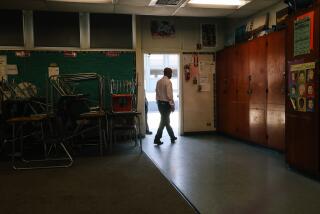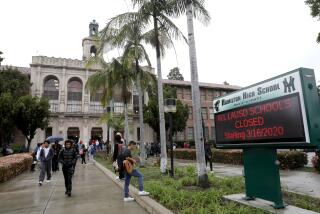School Board’s Christmas Wish : District Will Ask San Diegans to Hand Over State Rebate Checks to Help a Specific School
- Share via
The extent to which San Diego residents care about their schools is about to be tested by the San Diego Unified School District.
The five-member board unanimously approved a plan Tuesday to ask San Diegans to sign over their state tax-rebate checks to education--either to an individual school that they have a relationship with or to the district.
The board promised that all money received will be targeted for materials or instruction that will benefit students directly, and not be used for administrative purposes. Students, parents and faculty at each of the district’s 179 schools will be asked to draw up a list of five or six specific improvements that could be carried out if funds were available. The lists will then be used as carrots to attract support from the community.
Schools Fought for Surplus Funds
At issue are state revenues that school officials statewide earlier this year had hoped the Legislature and Gov. George Deukmejian would give to education. After political disagreements between legislators and Deukmejian over how to interpret the state constitutional spending limit, the money--$1.1 billion statewide--instead will be rebated to state taxpayers.
School districts statewide were forced to make substantial budget cuts, including San Diego’s having to slice $10.6 million in educational services, from music to language to sports, that otherwise would have been continued or expanded.
The average one-time rebate will be $32 to $236, and checks are scheduled to be mailed beginning in early November, just before the peak of the Christmas shopping season. Despite the holiday lure to consumers, school officials hope that they can persuade many residents to help out schools. The donation could be used as a tax deduction on an itemized tax return.
Challenge to the People
“For me, I remember a state poll (earlier this year) that showed 60% of state residents wanted this (surplus) to go to schools,” board President Kay Davis said Tuesday. “So this is a challenge to the people of San Diego to help students, whether they have kids in school, are retired and live by a school, or aid schools through one of our business partnerships.”
Davis said the challenge for schools will be to attract widespread support by coming up with innovative plans that could be funded with additional money.
“If schools can get students excited enough to go home and convince their parents to sign over the checks,” Davis said, “then we will be letting people feel some ownership as to what they want done with the checks.”
Both she and board member Susan Davis urged district officials to move quickly on the proposal by involving the numerous private companies and community groups that have adopted individual schools under the district’s partnerships-in-education program.
Should Keep Solicitation Flexible
Kay Davis stressed that the district should keep its solicitation as flexible as possible, allowing residents to send personal checks for only a portion of their rebate if that is their choice. Davis said residents should be able to divide their checks between two or more schools if desired.
“It would be a wonderful way to help and a wonderful way to send a message to our legislators,” Davis said.
The district has no idea how much money it might raise from the program, schools Supt. Tom Payzant said. Statewide, several school districts are considering similar plans, and the state Department of Education will soon issue legal guidelines for such solicitations, guidelines that San Diego says it will follow.
The only concern expressed Tuesday centered on possible inequalities if a particular school garners more money than another school. For that reason, school officials see the latest effort as only a salve, and are pushing a statewide effort by state schools Supt. Bill Honig for a ballot initiative to exempt education from the state’s spending limit.
More to Read
Sign up for Essential California
The most important California stories and recommendations in your inbox every morning.
You may occasionally receive promotional content from the Los Angeles Times.










